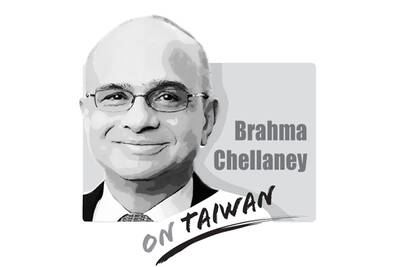Saturday’s presidential and legislative elections ensured that the Chinese Nationalist Party (KMT) will enjoy another four years of control in both the executive and legislative branches in the government.
Although the KMT maintained its legislative majority by winning 64 of the 113 seats, it suffered a net loss of 17 seats, while the Democratic Progressive Party (DPP) picked up 13 additional seats, giving it the ability to propose presidential and vice presidential recalls, as well as amendments to the Constitution because it holds more than a third of the legislature.
While the legislature will largely be dominated by the KMT and DPP, the strong showing by smaller parties was an intriguing result. The combination of the nation’s nine smaller parties received more than 20 percent of the party vote.
Both the People First Party (PFP) and Taiwan Solidarity Union (TSU) made their way back into the legislature by meeting the 5 percent party vote threshold, securing both parties legislator-at-large seats. And although the Green Party Taiwan failed to pass the 5 percent hurdle, it managed to garner 1.7 percent of the party vote.
The strong performance by the PFP, the TSU and the other small parties reflected the voters’ desire for a legislature with diverse representation. While voters still largely stuck with the two major parties when choosing a presidential candidate, they showed they were much more willing to take a chance on a smaller party when casting their party vote.
As the new legislative session begins on Feb. 1, we fully expect both the PFP and the TSU to use their position on the legislative floor to monitor the KMT and the DPP despite each being classified as members of the pan-blue and pan-green camps respectively.
We hope the fresh faces from the two parties’ legislator-at-large lists, including financial expert Thomas Lee (李桐豪) and writer Chang Hsiao-feng (張曉風) of the PFP, as well as lawyers Hsu Chun-hsin (許忠信) and Huang Wen-ling (黃文玲) of the TSU, will bring new possibilities to the legislature.
For the KMT, it must carry out President Ma Ying-jeou’s (馬英九) promise of paying more attention to labor, cultural, educational and environmental issues, as well as the views of its own legislators from its legislator-at-large list.
The KMT’s 16 legislators-at-large are mostly made up of non-party members, including Children’s Welfare League Foundation executive director Alicia Wang (王育敏), Taiwan Organization for Disadvantaged Patients secretary-general Yang Yu-hsing (楊玉欣) and Environmental Protection Administration Deputy Minister Chiu Wen-yen (邱文彥). As advocates in various fields, the KMT’s new legislators need to take advantage of their governing position and live up to the public’s expectations by facilitating the legislation of bills that will address issues ranging from social welfare and tax reform, to judicial reforms.
The DPP, being the largest party in opposition, must make more of an effort to monitor the KMT’s legislative performance and pay greater attention to the Ma administration’s cross-strait policies, as many peopel are worried that Ma will move full speed ahead on closer cross-strait ties now that he has secured a second, and final, term.
Finally, Ma must not ignore the voters’ call for fair and diverse representation in the legislature, and he must work to put an end to backroom deals. He should remember the promise he made in his victory speech — that the KMT will work harder to seek cooperation from opposition parties in the legislature and act more humbly to pass legislation that is aimed at creating a better environment for all Taiwanese.

As strategic tensions escalate across the vast Indo-Pacific region, Taiwan has emerged as more than a potential flashpoint. It is the fulcrum upon which the credibility of the evolving American-led strategy of integrated deterrence now rests. How the US and regional powers like Japan respond to Taiwan’s defense, and how credible the deterrent against Chinese aggression proves to be, will profoundly shape the Indo-Pacific security architecture for years to come. A successful defense of Taiwan through strengthened deterrence in the Indo-Pacific would enhance the credibility of the US-led alliance system and underpin America’s global preeminence, while a failure of integrated deterrence would
The Executive Yuan recently revised a page of its Web site on ethnic groups in Taiwan, replacing the term “Han” (漢族) with “the rest of the population.” The page, which was updated on March 24, describes the composition of Taiwan’s registered households as indigenous (2.5 percent), foreign origin (1.2 percent) and the rest of the population (96.2 percent). The change was picked up by a social media user and amplified by local media, sparking heated discussion over the weekend. The pan-blue and pro-China camp called it a politically motivated desinicization attempt to obscure the Han Chinese ethnicity of most Taiwanese.
On Wednesday last week, the Rossiyskaya Gazeta published an article by Chinese President Xi Jinping (習近平) asserting the People’s Republic of China’s (PRC) territorial claim over Taiwan effective 1945, predicated upon instruments such as the 1943 Cairo Declaration and the 1945 Potsdam Proclamation. The article further contended that this de jure and de facto status was subsequently reaffirmed by UN General Assembly Resolution 2758 of 1971. The Ministry of Foreign Affairs promptly issued a statement categorically repudiating these assertions. In addition to the reasons put forward by the ministry, I believe that China’s assertions are open to questions in international
The Legislative Yuan passed an amendment on Friday last week to add four national holidays and make Workers’ Day a national holiday for all sectors — a move referred to as “four plus one.” The Chinese Nationalist Party (KMT) and the Taiwan People’s Party (TPP), who used their combined legislative majority to push the bill through its third reading, claim the holidays were chosen based on their inherent significance and social relevance. However, in passing the amendment, they have stuck to the traditional mindset of taking a holiday just for the sake of it, failing to make good use of